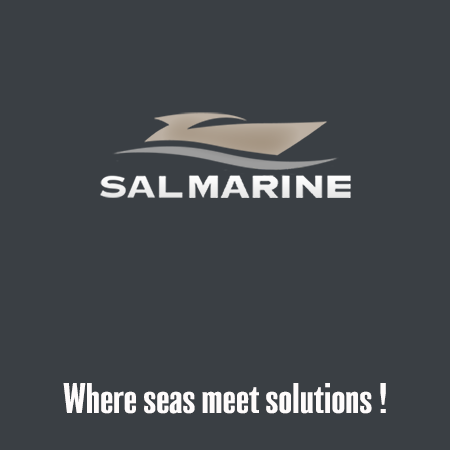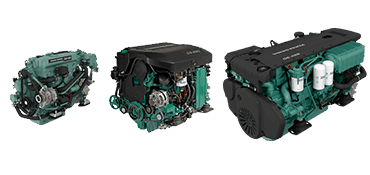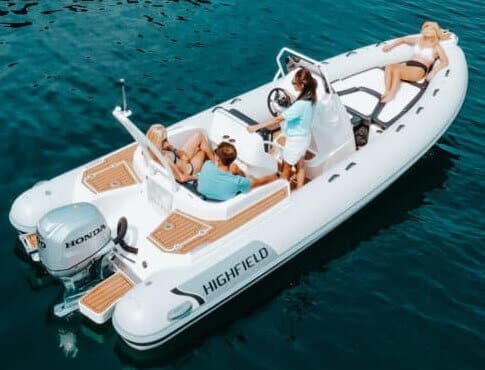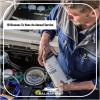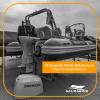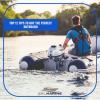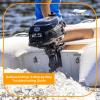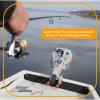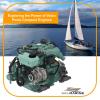Enhance Your Boat's Performance: A Comprehensive Guide

Are you encountering challenges with the performance of your inflatable boat?
Boating enthusiasts of are well aware that unlocking peak performance on the water is the key to ensuring a satisfying and efficient experience. While pursuing this goal, it's not uncommon to encounter issues with your boat and engine configuration. Fortunately, understanding how to effectively tackle these problems is crucial. These concerns often revolve around efficiently achieving planing, managing handling, optimizing speed, and enhancing acceleration.
Delve into the insights provided in this article to discover a plethora of valuable tips and techniques. We will delve into the most prevalent obstacles that impact boating performance and explore remedies that can effectively alleviate these issues.
Identifying Common Boating Performance Challenges
Porpoising Porpoising, a phenomenon where a boat's bow bounces rhythmically on the water's surface akin to a porpoise's movements, frequently arises at higher speeds. This occurrence can lead to instability, compromised control, reduced fuel efficiency, and a less than comfortable ride.
Bow Rise Another common concern is excessive bow rise, which transpires during acceleration. This can obstruct your visibility and compromise passenger safety. Additionally, it may hinder the boat's ability to achieve planing.
Imbalance Uneven weight distribution or overloading on your boat can result in imbalance. This not only affects stability but also exerts a significant influence on overall performance. Unequal weight distribution, particularly if one side is overloaded, can jeopardize safe handling.
Slow Planing Promptly achieving planing is essential for V-hulled boats. Lingering in a non-planing state can diminish both performance and fuel efficiency. Often, this is interlinked with other performance impediments, as the boat fails to reach the requisite speed and angle for hull lift.
Addressing Boating Performance Concerns
Weight Distribution The straightforward approach of adjusting weight distribution can profoundly impact your boat's performance and handling. Improper weight distribution can lead to diverse issues, such as bow rise due to excessive stern weight or the boat nosediving into waves due to excessive bow weight. A general guideline is to centralize weight distribution around the middle of the boat. Achieve this by positioning passengers and cargo accordingly. For solo travelers, an outboard tiller arm extender can be advantageous, enabling you to sit further forward and enhancing comfort.
Engine Trim Adjustment Modifying your engine or outboard trim is a simple yet effective way to enhance performance. Incorrect engine trim can result in bow rise, cavitation, or prolonged planing. Start with the outboard in the lowest trimmed position and gradually adjust until you find the optimal angle for your boat's conditions and weight distribution.
Outboard Hydrofoils Utilizing outboard hydrofoils can reduce drag and increase lift for certain setups. These aerodynamic surfaces mounted above the propeller's cavitation plate counteract bow rise, leading to quicker planing and smoother rides. While they may slightly decrease top-end speed, they enhance fuel efficiency at higher speeds.
Another critical aspect often overlooked in the pursuit of maximizing inflatable boat performance is maintaining the correct air pressure. The buoyancy, stability, handling, and overall experience of your inflatable boat are heavily influenced by the air pressure within its chambers. To ensure that your boat operates at its peak efficiency, here's what you need to know about maintaining the right air pressure:
The Importance of Proper Air Pressure
Inflatable boats rely on air chambers to provide buoyancy and shape. Incorrect air pressure can lead to various issues that affect both safety and performance. Overinflation can make the boat rigid and less responsive, while underinflation can reduce buoyancy, compromise stability, and increase drag. Therefore, it's crucial to find the perfect balance.
Determining the Correct Air Pressure
The recommended air pressure for your inflatable boat is often indicated by the manufacturer. This information might be located on the boat itself or within the owner's manual. It's essential to follow these guidelines closely. Different chambers within the boat might have different pressure requirements, so make sure to adjust each chamber according to the manufacturer's specifications.
Using a Pressure Gauge
A reliable pressure gauge is an indispensable tool for maintaining the correct air pressure in your inflatable boat. These gauges are easy to use and provide accurate readings. Regularly checking and adjusting the air pressure before each outing will ensure consistent performance and safety.
Inflating the Boat
When inflating your boat, it's recommended to use a high-quality pump equipped with a pressure gauge. Slowly and steadily inflate the chambers to the recommended pressure. Avoid using excessive force or rapid inflation, as this can lead to overinflation. If you're inflating the boat on a warm day, keep in mind that air expands as temperatures rise, so check and adjust the pressure as needed.
Monitoring Pressure During Use
Air pressure can fluctuate due to changes in temperature and usage. During extended periods on the water, it's not uncommon for air pressure to change. Therefore, it's a good practice to carry a portable pump with a pressure gauge on board. Regularly check the pressure and make adjustments as necessary to maintain optimal performance throughout your boating experience.
Sustaining Peak Performance: The Significance of Outboard Maintenance
While factors like weight distribution, engine trim, and air pressure play a pivotal role in enhancing your boat's performance, one element that should never be overlooked is the maintenance of your outboard engine. A well-maintained engine is the heart of your boat's performance, and neglecting its upkeep can lead to diminished efficiency, compromised handling, and even safety hazards. Here's why prioritizing outboard maintenance is crucial for improving your boat's overall performance:
Reliability and Consistency
A reliable outboard engine is essential for consistent and trouble-free boating experiences. Regular maintenance helps identify and address potential issues before they escalate, reducing the likelihood of unexpected breakdowns or performance disruptions during your outings. A well-maintained engine ensures that you can confidently embark on your boating adventures without worrying about sudden malfunctions.
Optimized Fuel Efficiency
A properly maintained outboard engine operates at its peak efficiency, resulting in better fuel economy. Engines that are not well-tuned or serviced can consume more fuel than necessary, impacting your budget and your environmental footprint. Routine maintenance, such as cleaning or replacing air filters, spark plugs, and fuel filters, contributes to better combustion and fuel efficiency.
Enhanced Performance and Acceleration
Regular maintenance keeps your engine components functioning optimally. Clean and properly lubricated parts allow for smoother operation, leading to improved acceleration, responsive throttle control, and better overall performance. Neglecting maintenance can result in sluggish acceleration, decreased top speeds, and less agile handling.
Extended Engine Lifespan
Just as your body needs regular check-ups to maintain good health, your outboard engine requires periodic maintenance to extend its lifespan. Routine servicing, such as changing oil and lubricating moving parts, reduces wear and tear, preventing premature engine deterioration. An engine that is well-cared for can provide reliable service for many seasons, ultimately saving you from costly repairs or premature replacements.
Safe and Enjoyable Boating
The safety of you, your passengers, and other boaters depends on a properly functioning engine. A well-maintained outboard engine ensures that you have full control over your boat, reducing the risk of sudden engine failure, loss of power, or navigational difficulties. By prioritizing maintenance, you contribute to a safer and more enjoyable boating experience for everyone on board.
Maintenance Checklist
To ensure your outboard engine remains in top condition, consider these essential maintenance tasks:
- Regular Oil Changes
- Inspection and Replacement of Spark Plugs
- Fuel System Cleaning and Filter Replacement
- Lubrication of Moving Parts
- Cooling System Flushing
- Propeller Inspection and Cleaning
- Battery Maintenance
- Inspection of Belts and Hoses
In Conclusion
Just as you invest time and effort into adjusting weight distribution, fine-tuning engine trim, and maintaining proper air pressure, dedicating attention to your outboard engine's maintenance is equally vital. Regular maintenance not only boosts performance but also enhances reliability, fuel efficiency, safety, and the overall longevity of your boat. By valuing and upholding the health of your engine, you're securing countless enjoyable and trouble-free voyages on the water.
